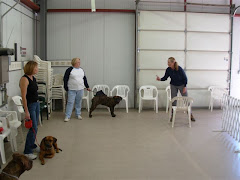 |
| Reactive |
"I correct Abby every time she does it, but she keeps on doing it," Linda wailed. "I hate to keep correcting her all the time!"
Linda was referring to the play-biting her Rhodesian Ridgeback puppy would start whenever she wanted attention. But Linda could have also been referring to a dog that jumps up on counters, chases deer, lunges at other dogs, or grabs Kleenex out of the waste basket. While any of these undesirable behaviors can be "fixed" by various methods, the common denominator in them is the human leader.
When Linda waits for Abby to do the bad deed, and then corrects her, Linda is being "reactive." She reacts to the dog's behavior. The problem with being "reactive" is that the dog quickly learns this is part of the game. Dog does "X" and owner does "Y." To him, it's just a routine.
Because the dog already got his gratification by doing "X," and because the dog may not particularly mind the reprimand, the dog decides it's worth it to him to repeat the behavior at another time.
Let's use a steak on a plate as an example: Your dog is hungry. He spies a steak sitting on a plate on the edge of the counter. He jumps up, grabs it, and gobbles it up as you come running over to discipline him. You're too late. The satisfaction of gulping down that juicy steak was far greater than his fear of retribution. Therefore, he'll probably do it again....if you're foolish enough to leave a steak on the edge of the countertop!
A "proactive" approach communicates far better leadership from you. Here's how you could be proactive in the same situation: the steak is on the countertop (not because you're baiting your dog but because that's just where you had to put it for the moment). You're quietly watching from the sidelines as you see your dog's nose twitch. The dog gets up and walks cautiously over toward the countertop. Ears are up, nose is still twitching. You know what he has in mind. THIS IS THE MOMENT you become a proactive leader. You step in with a swift "Leave it!" command or a sharp "Aagh!!" The dog glances at you, knowing he's busted before he even commits the deed. His ears go back submissively and he slinks back to his resting spot.
NOW YOU ROBUSTLY PRAISE YOUR DOG! You have just thwarted a dog-crime.You've convinced your dog that...
1. You can read his mind (and you can).
2. You are watching him at all times, like the good leader you are.
This message of leadership is far more effective than any "reactive" swat on the tush that may have come AFTER he'd committed the dastardly deed.
In Linda's case, she's going to learn to "read" her dog more carefully. She'll see the changes in body language and demeanor that tell her Abby's mood is swinging from playful pup to bratty teenager. She'll learn to intervene and redirect the dog's thoughts and energy BEFORE she becomes bratty. Regardless of what method she might use to do this, the key ingredient is her observation of Abby and her ability to be "proactive" in her approach.
 |
| Proactive |
Your dog wants to know you're in charge. Whether he's a Rottie or a Yorkie, he needs to have confidence in your ability to keep him safe. Without it, he has no choice but to promote himself to a rank higher than yours....and that, of course, is when you begin taking orders from him. If you wouldn't dream of putting your small children in this role, don't do it to your dog either.



















1 comment:
In the dog training business, Jan is a four-star master! If you like the subject of dogs, Check out Dogtalk on her blog...
Paul Campbell
Post a Comment